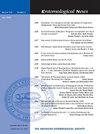美国内布拉斯加奥皮达纳Lutzomyia oppidana(直翅目:Psychodidae)首次记录
IF 0.4
4区 农林科学
Q4 ENTOMOLOGY
引用次数: 0
摘要
抽血沙蝇(Diptera:Psychodidae)是一种主要分布在热带的吸血昆虫;然而,一些近北物种向北延伸到加拿大(Young和Perkins,1984)。雌性在产卵前以血液作为蛋白质来源为食,是家畜、野生动物和人类的多种病原体的载体,包括病毒、细菌和原生动物(Ayala和Lee,1970;Young和Perkins,1984;Tesh,1988;Caceres,1993)。在美国,几种抽血沙蝇(直翅目:Psychodidae)已被指控或与水泡性口腔炎病毒的传播有关(Stalknech,2000;Schmidtmann等人,2002年)和格兰德河病毒(Calisher等人,1977年)。本文章由计算机程序翻译,如有差异,请以英文原文为准。
First Record for Lutzomyia oppidana (Diptera: Psychodidae) from Nebraska, USA
The phlebotomine sand flies (Diptera: Psychodidae) are blood-feeding insects with a predominantly tropical distribution; however, some Nearctic species range north into Canada (Young and Perkins, 1984). Females feed on blood as a protein source prior to laying eggs and are vectors of a wide range of pathogens including viruses, bacteria, and protozoans to domestic and wild animals and humans (Ayala and Lee, 1970; Young and Perkins, 1984; Tesh, 1988; Caceres 1993). In the United States, several species of phlebotomine sand fly (Diptera: Psychodidae) have been incriminated or associated with transmission of vesicular stomatitis virus (Stallknech, 2000; Schmidtmann et al., 2002) and Rio Grande virus (Calisher et al., 1977).
求助全文
通过发布文献求助,成功后即可免费获取论文全文。
去求助
来源期刊

Entomological News
生物-昆虫学
CiteScore
1.10
自引率
25.00%
发文量
17
期刊介绍:
Contributions are accepted on any of the aspects of systematics and taxonomy of insects. This includes: taxonomic revisions, phylogenetics, biogeography and faunistics, and descriptive morphology of insects. Taxonomic papers describing single species are acceptable if such a study is sufficiently justified, however, comprehensive studies that provide a comparative, integrated study of insect systematics and taxonomy will get priority.
 求助内容:
求助内容: 应助结果提醒方式:
应助结果提醒方式:


